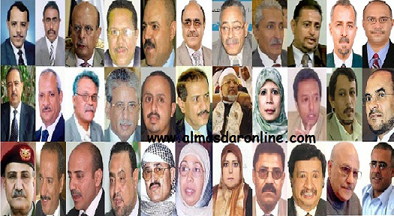
Over a week ago Yemen’s beleaguered President Ali Abdullah Salih finally stepped down after taking power in North Yemen 33 years ago during a military coup. Having promised three times to sign a deal worked out by the Gulf Cooperation Council, the fourth time was finally the charm. Saudi television carried the signing ceremony live from Riyadh, with the Saudi King Abdullah calling this a “turning of a new page†for its neighbor to the south.
The final details were negotiated by UN envoy Jamal Benomar. The transition is being directed by the current Vice-President Abd al-Rab Mansur al-Hadi. The first stage is forming a government of national reconciliation within two weeks. The new ministers will include half from the President’s ruling party and half from the opposition Joint Meeting Parties, with 20% of the positions reserved for women. In each case a minister of one party will have a deputy minister from another party. The cabinet has now been formed (click here to read the brief resumes of the cabinet officers in Arabic).
Among the far-reaching provisions the armed forces are supposed to be restructured so that no single faction has a dominant hand. Also, the demands of the youth and other protesters who took over “Change Square†are in theory to be seriously considered in open political discussions across the country. Following the election of a new president, the constitution will be reformed to ensure the continuing unity of north and south. If this sounds like a fairy tale, welcome to the politics of politics.
Salih’s voluntary, although belated, exit from power has taken a different path than the fall of other dictators in the so-called “Arab Spring.†Since late January hundreds of thousands of peaceful protesters have called for the end of his regime. Although Yemen is a country in which guns outnumber people by almost three to one, the protests did not erupt in violence. Early in the conflict the army split into two camps, one supporting President Salih and led by his son, and the other protecting the protesters and led by the powerful General Ali Muhsin al-Ahmar. Last June Salih was badly burned during a bomb blast in his private mosque and spent time recovering in Saudi Arabia. Since Salih’s return to Yemen from medical treatment in Saudi Arabia, tensions mounted and his loyalists intimidated the protesters with scores of civilian deaths, especially in the southern city of Taiz. UN Secretary General Ban Ki-moon announced that Salih will be traveling to New York for further medical treatment, but so far that has not happened.
Salih’s “irhal†is what the vast majority of Yemeni citizens have been waiting for, but many factions will not be satisfied by the terms of the agreement. One of the most controversial points is the granting of immunity to Salih, although ironically the agreement states that no one accused of human rights violations will be allowed to participate in the new government. The most vocal critic of granting Salih immunity is the recent Nobel Peace Prize recipient Tawakkul Karman. Yet this agreement has historical precedent in Yemen’s recent history, where reconciliation was achieved between combatants after the bloody civil war of the 1960s in the north. This also reflects Yemen’s tribal customary law, in which mediation and restitutive compensation lead to ultimate reconciliation. The current agreement also echoes the unification of North and South Yemen in 1990, when ministers from both states were merged into the new and evolving republic.
In the past decade the United States has propped up Salih’s regime with millions of dollars in military aid, primarily targeted against Al Qaeda. While the major Al Qaeda operatives in Yemen have now been killed or captured, civilian casualties from drone strikes have angered many Yemenis. A recent report from the Combating Terrorism Center at West Point notes that our policy in Yemen has been counter-productive, exaggerating the role which Yemen’s tribes are said to play in creating a safe haven for terrorists.
Despite the promise envisioned in the agreement, Yemen’s problems are not going to be resolved any time soon. The protests were not mainly about the abuse Salih directed toward his opponents, as in Libya, but the culture of corruption and cronyism that dominated the regime. Some of the same politicians have been recycled int the interim cabinet. The main obstacles to forming a new government are internal to Yemen. Southern resentment at their marginalization and increased poverty after unification has led to a secessionist movement. In the north the Huthi rebellion against Sunni Salafi Islam imported from Saudi Arabia continues. In Yemen today there are almost 200,000 Somali refugees fleeing the turmoil in their homeland. The least of all worries, despite common stereotypes, comes from Yemen’s tribes, which define the bulk of the population. The civil society they represent has been the backbone of Yemen’s survival for centuries and will continue to play a vital role. There is much to watch as events unfold in the next few weeks.
Daniel Martin Varisco